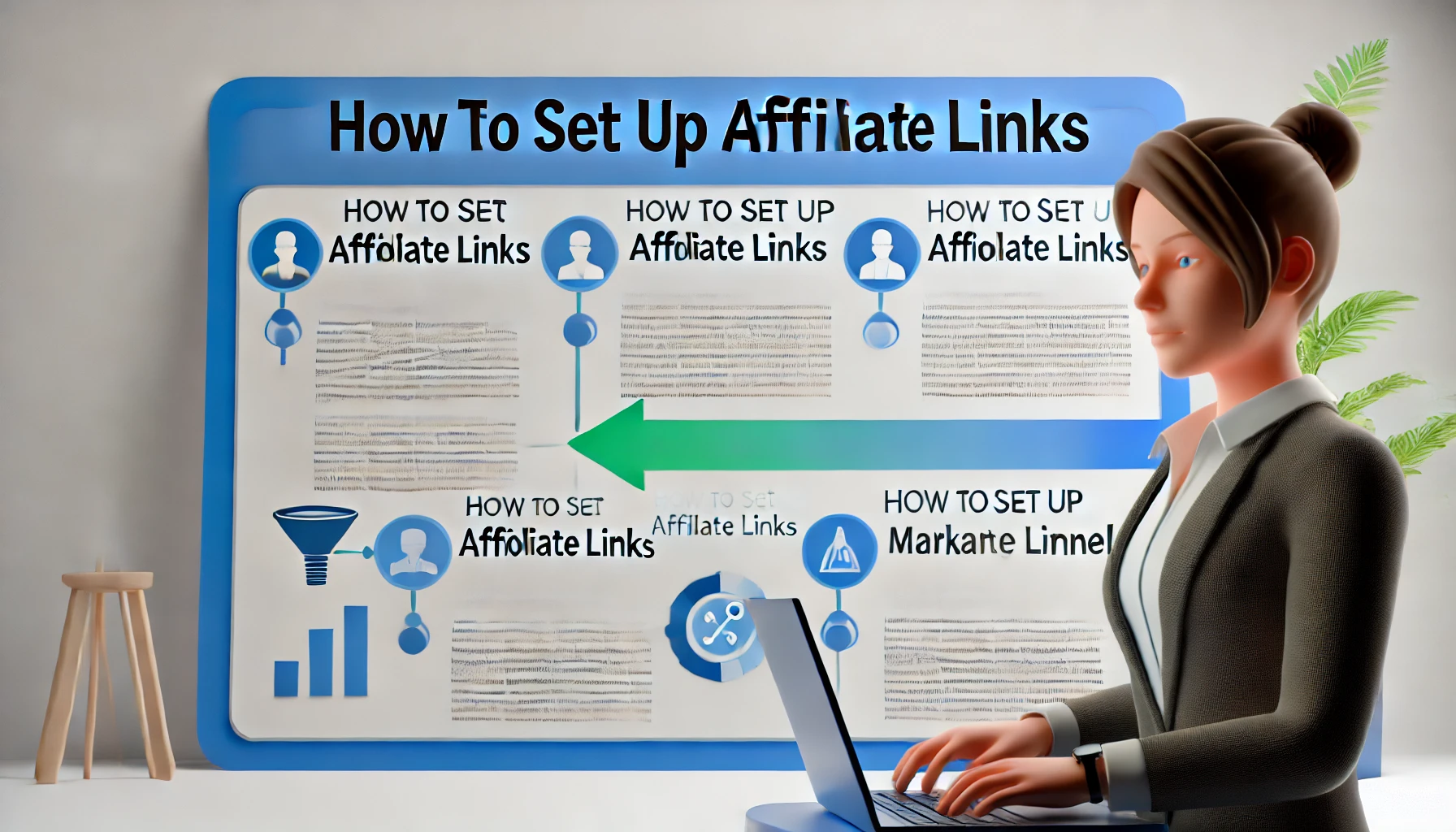Table of Contents
Are you looking to make passive income online but unsure of how to set up affiliate links effectively? Setting up affiliate links can be a game-changer, helping you monetize content while adding value to your audience.
In this guide, we’ll answer all your questions and provide a step-by-step breakdown on how to set up affiliate links, optimize them for conversions, and track their performance. Whether you’re new to affiliate marketing or looking to enhance your current setup, this guide has you covered.
Understanding Affiliate Links And Their Benefits
Affiliate links are a powerful way to monetize content by earning commissions on sales driven from your site. These links direct users to products or services that align with your content, creating value for your audience and passive income potential for you.
What Are Affiliate Links And How They Work?
Affiliate links are unique URLs provided by affiliate programs, allowing content creators to earn a commission when users click through and make a purchase. These links track sales back to you, enabling brands to reward your promotional efforts. Understanding this flow is essential for using affiliate marketing effectively.
Affiliate links typically contain special identifiers or tracking codes. This unique element lets the brand or affiliate network attribute each click and purchase back to your account. The setup makes it easy for marketers to promote products, track sales, and receive payouts based on successful conversions.
For marketers, affiliate links provide a straightforward revenue model. You don’t need to handle inventory, fulfillment, or customer service – the focus is on crafting content that resonates with your audience and encourages clicks. This simplicity makes affiliate marketing accessible to a wide range of content creators.
Key Benefits of Using Affiliate Links In Content
One major benefit of affiliate links is their potential to create a passive income stream. Once set up, these links can generate revenue from clicks and purchases without ongoing effort, making it a sustainable revenue source for content creators.
Affiliate links can also enhance the value of your content. By carefully selecting relevant products, you can offer helpful recommendations, improving your credibility and trustworthiness with readers. This connection increases reader engagement and adds depth to your content.
Another advantage is the scalability of affiliate marketing. As your content grows, so does your earning potential. You can place links across various types of content – articles, videos, or even emails – to maximize the chances of conversions, amplifying your revenue opportunities.
Common Types of Affiliate Links for Marketers
One popular type is product links, which send users directly to a specific product page. These links are ideal for product reviews or recommendations, offering readers a quick route to the exact item you’re discussing.
Another option is category links, which guide users to a product category rather than a specific item. These links work well in content focused on broader topics, like “best laptops” or “top kitchen gadgets,” encouraging users to explore a range of products.
Finally, deep links lead users to a specific page within a website, often beyond the homepage. Deep links can be used creatively to direct readers to promotional pages or limited-time offers, helping you drive higher conversion rates by targeting specific user interests.
Choosing The Right Affiliate Programs To Join

Selecting the right affiliate program is key to maximizing your earnings and relevance. With countless programs available, you’ll want to consider profitability, commission rates, and niche alignment to ensure the program complements your content and audience.
Evaluating Affiliate Programs For Profitability
I suggest starting by evaluating potential earnings for each affiliate program. Some programs offer flat-rate commissions, while others use percentage-based earnings. Understanding the payout structure helps you assess the true profitability of each option.
Look into the program’s payment terms as well. While some programs pay monthly, others may have higher thresholds for payouts. This factor impacts how quickly you see returns on your affiliate efforts, so choose a structure that matches your cash flow needs.
Consider how the program’s products align with your audience’s needs. A profitable program with high commissions is only effective if the products resonate with your readers. Check if the products reflect your content’s focus to ensure seamless integration.
Finding High-Commission Affiliate Programs
High-commission programs can significantly boost your earnings, especially when targeting high-ticket items. Many programs in finance, software, and luxury goods tend to offer higher commissions, providing an attractive earning opportunity for content creators.
When searching for high-commission options, research each program’s reputation and product quality. Programs with generous payouts but low-quality products can harm your credibility. I suggest choosing programs with both good commissions and quality products to build trust.
Look for programs with recurring commissions. For example, software or subscription-based services often offer recurring payments as long as users stay subscribed. These programs can provide a sustainable income stream, rewarding long-term engagement.
Selecting Niche-Specific Affiliate Programs
Targeting niche-specific programs allows you to connect more deeply with your audience. When programs align with your niche, your recommendations feel more relevant and credible, enhancing your content’s value and engagement.
Niche programs also cater to more specific audiences, often with higher buying intent. For instance, pet care bloggers can focus on pet product affiliate programs, reaching readers actively seeking those items. This targeted approach can lead to higher conversions.
I recommend seeking exclusive niche programs. Smaller or unique programs may offer exclusive products or perks, setting you apart from competitors. Exclusive links can enhance reader loyalty, as they find content tailored specifically to their interests.
How To Set Up Affiliate Links On Your Website
Setting up affiliate links on your website is straightforward but requires strategy to ensure effectiveness. From placement to format, following best practices can help maximize clicks and conversions on your affiliate links.
Preparing Your Website For Affiliate Links
Preparing your site for affiliate links starts with choosing the right pages. I advise identifying high-traffic pages that align with your affiliate products, as these are more likely to drive clicks and conversions.
Optimizing site speed is also essential for affiliate success. Slow pages may lose visitors before they click, so consider using tools to improve load times. A faster site keeps users engaged, increasing the chances of link clicks.
Ensure that your website layout supports affiliate links. Using visible, easy-to-navigate placements makes links accessible without disrupting user experience. Consistent formatting and placement can improve click-through rates by creating familiarity.
Adding Affiliate Links To Blog Posts And Pages
To add affiliate links effectively, I suggest embedding them within relevant blog posts and pages. When links feel natural and enhance content value, they’re more likely to generate interest and engagement from readers.
Consider using anchor text that clearly describes the product or service. Instead of generic phrases like “click here,” opt for descriptive terms that set expectations, like “top-rated DSLR camera.” This technique increases the likelihood of conversions by guiding readers.
Ensure that your affiliate links add to the reader experience rather than overwhelming it. Moderation is key; using too many links can feel pushy, while a few strategic placements keep the focus on content quality and usefulness.
How To Set Up Affiliate Links In Product Reviews
Product reviews are an ideal place for affiliate links, as readers are often looking for purchase guidance. Start by incorporating links at key points, like in product descriptions and “pros and cons” sections, where readers actively evaluate options.
Using comparison tables can also improve link performance. By visually contrasting features, prices, and benefits, you help readers make quick, informed decisions, increasing click-through rates. Link to products in each row to maximize accessibility.
I suggest ending each review with a clear call to action. This approach encourages readers to click through and purchase, capturing those who may still be undecided. Calls to action create a final nudge, driving conversions effectively.
Using Affiliate Links In Email Campaigns
Affiliate links in emails can boost conversions, especially when sent to a targeted list. Start by ensuring that the content is valuable to readers; promotional links work best when paired with helpful information or tips.
Focus on short, persuasive calls to action within your emails. Using phrases like “discover our favorite tool” or “learn about top-rated products” encourages clicks without feeling pushy. Strategic CTAs make the links feel natural and compelling.
Remember to use proper disclosures in emails. Transparency builds trust and helps your audience feel more comfortable engaging with the links. A simple line, like “This email contains affiliate links,” can go a long way in fostering credibility.
Optimizing Affiliate Links For Higher Conversions

Boosting affiliate link conversions involves strategic placement, compelling anchor text, and ongoing tweaks. When optimized, affiliate links seamlessly fit into content, encouraging clicks without feeling intrusive. Let’s look at key tactics to optimize your affiliate links effectively.
Strategic Placement Of Affiliate Links In Content
Placing affiliate links in relevant, high-traffic sections is essential. I suggest positioning links in the introduction and conclusion of articles, where readers are most engaged. Links in these spots attract attention naturally, boosting click-through rates.
Consider the link’s relevance to the surrounding content. Affiliate links work best when they directly match the topic, so aligning links with content topics increases conversions. For instance, a link to kitchen tools in a recipe post feels useful and well-placed.
Lastly, avoid overloading pages with links. Too many links can overwhelm readers, reducing clicks. A balanced approach, with links spread logically, creates a user-friendly experience that encourages readers to explore without feeling pressured.
How To Write Persuasive Anchor Text For Links
Using descriptive and persuasive anchor text makes a significant difference. Rather than generic phrases, I recommend specific, value-driven language, like “top-rated headphones for quality sound.” This clear description informs readers and encourages them to click.
The tone of your anchor text also matters. Friendly and inviting phrases like “check out this popular choice” help create curiosity. By framing the link as a helpful suggestion, readers feel guided rather than pushed, enhancing their trust and interest.
Avoid keyword stuffing in anchor text. A natural, conversational tone works better and improves the flow of your content. Instead, focus on meaningful phrases that highlight the product’s value, which makes each link more attractive to readers.
Testing And Tweaking Links For Optimal Results
Testing your affiliate links reveals which strategies perform best. I suggest using A/B testing to compare link placements and anchor text variations, helping you identify high-converting formats. This approach ensures your efforts are based on data, not assumptions.
Regular tweaks can keep your links effective. Changing a link’s position or updating anchor text based on test results often boosts click rates. Continuous adjustments make sure your links adapt to shifts in reader behavior, improving overall conversions.
I also advise tracking which links perform well and which need improvement. Keeping an eye on performance data allows you to refine strategies, ultimately leading to a more responsive and profitable affiliate link setup over time.
Ensuring Compliance With Affiliate Link Regulations
Staying compliant with affiliate link regulations is crucial. Proper disclosures help maintain transparency with your audience and protect you legally. Following guidelines and disclosure best practices ensures you’re compliant and trustworthy in your affiliate marketing.
Important Affiliate Disclosure Guidelines
Affiliate disclosures are essential for transparency. I recommend placing clear disclosures near affiliate links, so readers know upfront that you may earn a commission. This openness builds trust and meets regulatory guidelines set by authorities like the FTC.
Disclosure language should be simple and easy to understand. Phrases like “This post contains affiliate links” or “I may earn from qualifying purchases” work well. This direct approach keeps readers informed without disrupting the flow of your content.
Always place disclosures where they’re easily visible. Some people add them at the beginning of posts or near links. These placements ensure compliance while respecting your readers, helping them make informed choices as they engage with your content.
Tips For Adding Clear Affiliate Disclosures
Adding disclosures is straightforward. I suggest using a consistent disclosure phrase across your content to create clarity. Readers will quickly recognize it, making the disclosure feel natural and non-intrusive in your articles or emails.
The placement of disclosures is key. Embed them within or near the affiliate links, so readers don’t have to search for them. Placing disclosures right before the link creates a smooth reading experience, respecting both compliance and user convenience.
Consider using a slightly different font or color for your disclosures to make them stand out without disrupting your content. Subtle styling changes can ensure disclosures are noticed and easily readable, further improving transparency and compliance.
Avoiding Common Compliance Mistakes
One common mistake is placing disclosures at the end of content. Readers may miss it, leading to unintentional non-compliance. I suggest positioning disclosures early to ensure clarity and compliance throughout your entire post.
Another pitfall is using complex language. Avoid industry jargon; instead, keep disclosures conversational. Your audience should understand it at a glance, so using simple, direct wording makes your intentions clear and aligns with compliance guidelines.
Finally, remember that social media posts with affiliate links also require disclosures. Simple hashtags like “#ad” or “#affiliate” ensure transparency, making it easy for followers to know when content is monetized and building trust in your recommendations.
Tracking And Analyzing Affiliate Link Performance

Tracking affiliate link performance is essential for refining your strategy. By understanding what works and what doesn’t, you can adjust your approach to maximize earnings. Using tracking tools and focusing on key metrics helps optimize link effectiveness.
How To Set Up Tracking For Affiliate Links
Setting up tracking allows you to monitor clicks and conversions for each link. I recommend using tools like Google Analytics or specialized affiliate platforms to gain insights. This setup helps you see which links resonate most with your audience.
Consider assigning unique identifiers to each link. Tracking IDs make it easy to trace clicks back to specific placements, helping you understand which content types drive the most traffic. This strategy refines your approach by highlighting what readers prefer.
Reviewing tracking data regularly helps you stay on top of performance. I advise setting aside time each month to analyze the data, allowing you to identify trends and make strategic adjustments that keep your affiliate efforts profitable and effective.
Top Tools For Analyzing Affiliate Link Performance
There are many tools to help track affiliate performance. Google Analytics is versatile and widely used, offering deep insights into user behavior and click patterns on your site. It’s a valuable resource for detailed performance tracking.
Affiliate networks often provide built-in analytics tools. Many platforms offer dashboards to review click rates, conversions, and earnings at a glance. I recommend exploring these tools if you want an easy way to monitor specific affiliate programs.
Consider specialized affiliate tracking software for more advanced analysis. Platforms like ClickMeter or ThirstyAffiliates are designed specifically for tracking and optimizing affiliate links, providing a detailed view of how each link performs over time.
Understanding Key Metrics For Link Success
Understanding the right metrics is crucial to refining your strategy. Click-through rate (CTR) measures how often links are clicked. A higher CTR indicates strong interest, so I recommend monitoring this metric closely to gauge reader engagement.
Conversion rate reveals how many clicks turn into purchases. High conversion rates mean readers find your recommendations relevant and valuable. Tracking this metric helps you understand which products resonate best and drive the most revenue.
Average order value (AOV) can show which affiliate links lead to higher-value purchases. By tracking AOV, you can focus on high-performing products and adjust your content to feature items that boost your overall earnings per conversion.
Tips To Improve Affiliate Marketing Strategy Long-Term
Building a successful affiliate marketing strategy requires consistent effort and adaptation. I suggest focusing on content, SEO, and audience engagement to create a long-lasting affiliate marketing approach that evolves with industry trends and keeps readers interested.
Scaling Affiliate Marketing With Content Strategy
A robust content strategy is key to growing affiliate marketing. I recommend creating valuable, targeted content that naturally includes affiliate links. Regularly publishing relevant articles, guides, and product reviews helps attract and retain a loyal audience.
Explore various content types to reach different reader segments. Blog posts, videos, and infographics can all showcase affiliate links effectively. Using multiple formats allows you to tap into diverse audience preferences, which broadens your reach and potential earnings.
Consider updating older content to keep it fresh and relevant. I advise reviewing and enhancing past posts with new information or updated links, which can help boost visibility and engagement, making your content strategy more impactful over time.
Leveraging SEO To Boost Affiliate Link Visibility
SEO is essential for improving affiliate link visibility. I suggest optimizing each page’s keywords, meta descriptions, and headings to attract search engine traffic. This approach increases organic clicks, which can lead to more affiliate conversions.
Targeting long-tail keywords can also be effective. Long-tail keywords are more specific and often have lower competition, making it easier to rank higher. With better rankings, your links reach a targeted audience actively searching for your content.
Incorporating internal links between related articles can keep visitors on your site longer. Linking relevant content encourages readers to explore further, increasing the chances they’ll engage with your affiliate links as they discover more value across your site.
Engaging Audiences To Drive Affiliate Conversions
Engagement is a powerful tool for affiliate marketing success. Engaging with readers builds trust and helps them feel connected. I suggest asking questions, responding to comments, and sharing personal insights to foster interaction with your content.
Email newsletters are another effective engagement strategy. Through regular emails, you can highlight valuable products or new content with affiliate links, reaching your audience in a more direct, personal way. This approach keeps readers interested in your recommendations.
Social media also offers engagement opportunities. Sharing content on platforms like Instagram or Twitter allows you to reach followers more frequently, fostering community and conversation. Active social media presence can drive consistent traffic and conversions from engaged audiences.
Common Mistakes To Avoid When Setting Up Affiliate Links

Setting up affiliate links effectively requires careful strategy. I recommend avoiding common pitfalls such as overusing links, prioritizing quality, and learning from mistakes to create a seamless, valuable experience for your readers and increase conversion rates.
Avoiding Overuse Of Affiliate Links In Content
Overloading content with affiliate links can overwhelm readers, leading to reduced engagement. I suggest placing links strategically within the content, focusing on a few well-placed links rather than flooding the page. This keeps the reading experience smooth and enjoyable.
Overuse of links can also affect credibility. When readers sense excessive promotion, it may feel intrusive. By keeping link placement subtle and relevant, you maintain readers’ trust, which is crucial for conversions and long-term success.
Limiting link usage allows you to focus on quality. Well-selected, relevant links have a greater impact and encourage genuine interest. Readers are more likely to click when links add value, making moderation key to successful affiliate marketing.
Choosing Quality Over Quantity With Links
Selecting quality links over quantity enhances your content’s value. I recommend focusing on high-quality affiliate programs with reputable products that align well with your niche. Relevant, trustworthy links boost credibility and improve reader engagement.
Quality links tend to perform better over time. Linking to valuable, well-reviewed products that resonate with your audience creates a connection. Readers are more likely to click links that feel curated and thoughtfully chosen, leading to higher conversion rates.
Prioritizing quality also makes your content feel more authentic. When links genuinely support the topic, readers sense your interest in helping them. I believe this approach fosters loyalty and creates a more positive reader experience overall.
Learning From Affiliate Marketing Mistakes
Learning from mistakes is vital for improvement. Reviewing past performance helps identify what worked and what didn’t. I suggest regularly analyzing link performance to spot areas for enhancement, which can sharpen your overall affiliate strategy.
Mistakes offer insights into audience preferences. If certain links underperformed, consider whether the products aligned with reader interests. Adjusting to these insights makes future recommendations more relevant, boosting your chances of conversion.
Embrace testing and experimentation to fine-tune your approach. Trying new link placements or anchor texts can reveal untapped potential. By staying open to learning, you’ll keep improving and adapting to make your affiliate strategy more effective.






